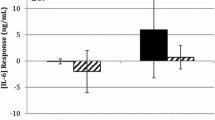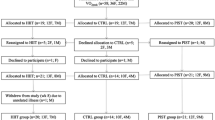Abstract
This study investigated the acute effects of two exercise modes, including cycle ergometry and modified rugby on inflammation and glucose regulation within an Indigenous Australian population. Ten sedentary, untrained Indigenous male participants volunteered to participate and were not clinically diagnosed with cardiovascular or metabolic disorders. Following baseline testing and in a randomized cross-over design participants completed two exercise protocols (cycle ergometry and modified rugby) of 40-min duration separated by 7 days’ recovery. Fasting venous blood was collected pre, post, 30, 60 and 240 min post exercise for analysis of glucose, insulin, cortisol and inflammatory markers of tumour necrosis factor (TNF)-α, interleukin (IL)-1β, IL-6, IL-1 receptor agonist (ra) and C-reactive protein (CRP). IL-6 and IL-1ra were significantly (P < 0.05) increased within the 240 min post-exercise period, without significant differences between protocols (P > 0.05). There were no significant changes within or between protocols for TNF-α, IL-1β and CRP (P > 0.05). A comparison of insulin resistance: homeostasis model (HOMA) between resting and 240 min post exercise shows a change from a baseline value of 4.44 (3.71) to 1.76 (1.67) HOMA in cycle ergometry (P < 0.05) and to 1.54 (1.33) HOMA in modified rugby (P < 0.05), without differences between sessions (P > 0.05). This study identified similar acute inflammatory and glucose regulatory responses between cycle ergometry and modified rugby. Prescribing modified rugby as a mode of physical activity may provide Indigenous populations with a community-based approach to promote increased engagement in physical activity and assist in the acute regulation of glucose disposal and inflammatory cytokines.


Similar content being viewed by others
Abbreviations
- CVD:
-
Cardiovascular disease
- CRP:
-
C-reactive protein
- GPS:
-
Global positioning satellite
- GXT:
-
Graded exercise test
- HR:
-
Heart rate
- HOMA:
-
Insulin resistance: homeostasis model
- IL:
-
Interleukin
- MHR:
-
Maximum heart rate
- VO2 :
-
Oxygen consumption
- Ra:
-
Receptor agonist
- TB-FM:
-
Total body fat mass
- TNF-α:
-
Tumor necrosis factor alpha
- T2DM:
-
Type 2 diabetes mellitus
References
Albert MA (2007) Inflammatory biomarkers, race/ethnicity and cardiovascular disease. Nutr Rev 65:S234–S238
Andersen LJ, Randers MB, Westh K, Martone D, Hansen PR, Junge A, Dvorak J, Bangsbo J, Krustrup P (2010) Football as a treatment for hypertension in untrained 30–55 year-old men: a prospective randomized study. Scand J Med Sci Sports 20:98–102
Brukner PD, Brown WJ (2005) Is exercise good for you? Med J Aust 183:538–541
Cleland SJ, Sattar N (2005) Impact of ethnicity on metabolic disturbance, vascular dysfunction and atherothrombotic cardiovascular disease. Diabetes Obes Metab 7:463–470
Coutts AJ, Duffield R (2010) Validity and reliability of GPS devices for measuring movement demands of team sports. J Sci Med Sport 13:133–135
Eriksson KF, Lindgärde F (1991) Prevention of type 2 (non-insulin-dependent) diabetes mellitus by diet and physical exercise. The 6 year Malmö feasibility study. Diabetologia 34:891–898
Fischer CP (2006) Interleukin-6 in acute exercise and training: what is the biological relevance? Exerc Immunol Rev 12:6–33
Hill AM, LaForgia J, Coates AM, Buckley JD, Howe PRC (2007) Estimating abdominal adipose tissue with DXA and anthropometry. Obes 15:504–510
Hill-Haas SV, Dawson B, Impellizzeri FM, Coutts AJ (2011) Physiology of small-sided games training in football: a systematic review. Sports Med 41:199–220
Jamurtas AZ, Theocharis V, Koukoulis G, Stakias N, Fatouros IG, Kouretas D, Koutedakis Y (2006) The effects of acute exercise on serum adiponectin and resistin levels and their relation to insulin sensitivity in overweight males. Eur J Appl Physiol 97:122–126
Janssen I, Katzmarzyk P, Ross R (2004) Waist circumference and not body mass index explains obesity-related health risk. Am J Clin Nutr 79:379–384
Kennett DC, Kempton T, Coutts AJ (2011) Factors affecting exercise intensity in rugby-specific small-sided games. J Strength Condit Res doi:10.1519/JSC.0b013e31823a3b26
Kim J, Wang ZM, Heymsfield SB, Baumgartner RN, Gallagher D (2002) Total-body skeletal muscle mass: estimation by a new dual-energy X-ray absorptiometry method. Am J Clin Nutr 76:378–383
Kindermann W, Schnabel A, Schmitt WM, Biro G, Cassens J, Weber F (1982) Catecholamines, growth hormone, cortisol, insulin, and sex hormones in anaerobic and aerobic exercise. Eur J Appl Physiol 49:389–399
Kramer HF, Goodyear LJ (2007) Exercise, MAPK, and NF-{kappa} B signaling in skeletal muscle. J Appl Physiol 103:388–395
Krustrup P, Aagaard P, Nybo L, Petersen J, Mohr M, Bangsbo J (2010) Recreational football as a health promoting activity: a topical review. Scand J Med Sci Sports 20:1–13
Matthews DR, Hosker JP, Rudenski AS, Naylor BA, Treacher DF, Turner RC (1985) Homeostasis model assessment: insulin resistance and cell function from fasting plasma glucose and insulin concentrations in man. Diabetologia 28:412–419
McAuley E (1989) Psychometric properties of the intrinsic motivation inventory in a competitive sport setting: a confirmatory factor analysis. Res Quart Exerc Sport 60:48–58
McDermott R, Rowley KG, Lee AJ, Knight S, O’Dea K (2000) Increase in prevalence of obesity and diabetes and decrease in plasma cholesterol in a central Australian Aboriginal community. Med J Aust 172:480–484
Mendham AE, Donges CE, Liberts EA, Duffield R (2011) Effects of mode and intensity on the acute exercise-induced IL-6 and CRP responses in a sedentary, overweight population. Eur J Appl Physiol 111:1–11
O’Dea K (2005) Preventable chronic diseases among Indigenous Australians: the need for a comprehensive national approach. Heart Lung Circ 14:167–171
Okita K, Nishijima H, Murakami T, Nagai T, Morita N, Yonezawa K, Lizuka K, Kawaguchi H, Kitabatake A (2004) Can exercise training with weight loss lower serum C-reactive protein levels? Arterioscler Thromb Vasc Biol 2:1868–1873
Pan XR, Li GW, Hu YH, Wang J, Yang W, An Z et al (1997) Effects of diet and exercise in preventing NIDDM in people with impaired glucose tolerance. The Da Qing IGT and Diabetes Study. Diabetes Care 20:537–544
Pedersen BK, Febbraio MA (2008) Muscle as an endocrine organ: focus on muscle-derived interleukin-6. Physiol Rev 88:1379–1406
Pedersen BK, Steensberg A, Keller P, Keller C, Fischer C, Hiscock N, Van Hall G, Plomgaard P, Febbraio MA (2003) Muscle derived interleukin-6: lipolytic, anti-inflammatory and immune regulatory effects. Eur J Physiol 446:9–16
Petersen AMW, Pedersen BK (2005) The anti-inflammatory effect of exercise. J Appl Physiol 98:1154–1162
Ridker PM, Rifai N, Pfeffer M, Sacks F, Lepage S, Braunwald E (2000a) Elevation of tumor necrosis factor-{alpha} and increased risk of recurrent coronary events after myocardial infarction. Circulation 101(18):2149–2153
Ridker PM, Rifai N, Stampfer MJ, Hennekens CH (2000b) Plasma concentration of interleukin-6 and the risk of future myocardial infarction among apparently healthy men. Circulation 101(15):1767–1772
Rowley KG, Best JD, McDermott R, Green EA, Piers LS, O’Dea K (1997) Insulin resistance syndrome in Australian Aboriginal people. Clin Exp Pharmacol Physiol 24:776–781
Rowley KG, Daniel M, Skinner K, Skinner M, White GA, O’Dea K (2000a) Effectiveness of a community directed ‘healthy lifestyle’ program in a remote Australian Aboriginal community. Aust N Z J Public Health 24:136–144
Rowley KG, Gault A, McDermott R, Knight S, McLeay T, O’Dea K (2000b) Reduced prevalence of impaired glucose tolerance and no change in prevalence of diabetes despite increasing BMI among Aboriginal people from a group of remote homeland communities. Diabetes Care 23:898–904
Rowley K, Walker KZ, Cohen J, Jenkins AJ, O’Neal D, Su Q, Best JD, O’Dea K (2003) Inflammation and vascular endothelial activation in an Aboriginal population: relationships to coronary disease risk factors and nutritional markers. Med J Aust 178:495–500
Thompson SJ, Gifford SM (2000) Trying to keep a balance: the meaning of health and diabetes in an urban Aboriginal community. Soc Sci Med 51:1457–1472
Thompson PD, Crouse SF, Goodpaster B, Kelley D, Moyna N, Pescatello L (2001) The acute versus the chronic response to exercise. Med Sci Sports Exerc 33:S438–S445
Unwin N, Shaw J, Zimmet P, Alberti K (2002) Impaired glucose tolerance and impaired fasting glycaemia: the current status on definition and intervention. Diabet Med 19:708–723
Valery PC, Moloney A, Cotterill A, Harris M, Sinha AK, Green AC (2009) Prevalence of obesity and metabolic syndrome in Indigenous Australian youths. Obes Rev 10:255–261
Wallace TM, Levy JC, Matthews DR (2004) Use and abuse of HOMA modeling. Diabetes Care 27:1487–1495
Wang Z, Hoy WE (2007) C-reactive protein and the risk of developing type 2 diabetes in Aboriginal Australians. Diabetes Res Clin Pract 76:37–43
Zimmet P, Shaw J, Alberti K (2003) Preventing type 2 diabetes and the dysmetabolic syndrome in the real world: a realistic view. Diabet Med 20:693–702
Acknowledgments
The authors would like to acknowledge the University of Technology, Sydney for providing the funding required for blood analysis. The authors would also like to acknowledge staff at Pathology, Bathurst Base Hospital NSW, Australia, and the Institutional staff at Charles Sturt University Exercise Physiology Laboratories, Bathurst, NSW, for assistance and support involving blood analysis. They would also like to acknowledge all participants and members of the Aboriginal community for their involvement and support in the research study
Conflict of interest
The authors declare that they have no conflict of interest
Author information
Authors and Affiliations
Corresponding author
Additional information
Communicated by Michael Lindinger.
Rights and permissions
About this article
Cite this article
Mendham, A.E., Coutts, A.J. & Duffield, R. The acute effects of aerobic exercise and modified rugby on inflammation and glucose homeostasis within Indigenous Australians. Eur J Appl Physiol 112, 3787–3795 (2012). https://doi.org/10.1007/s00421-012-2361-5
Received:
Accepted:
Published:
Issue Date:
DOI: https://doi.org/10.1007/s00421-012-2361-5




